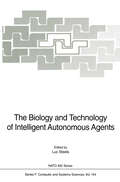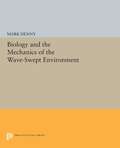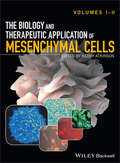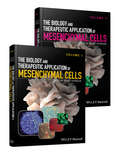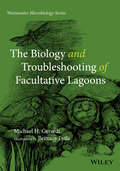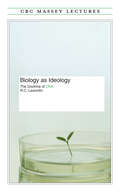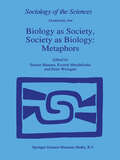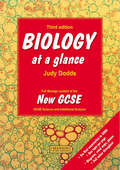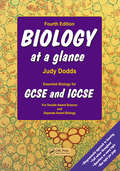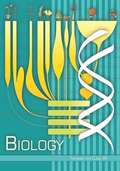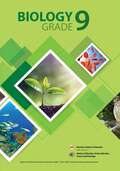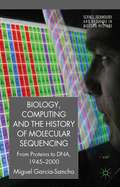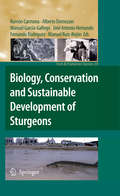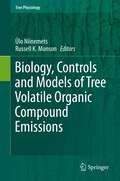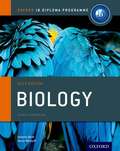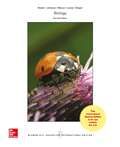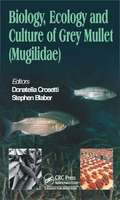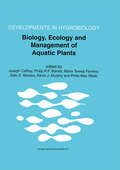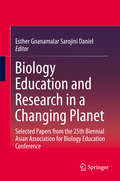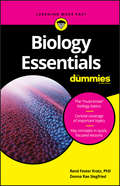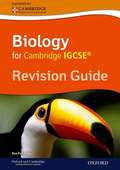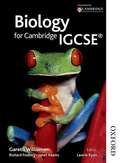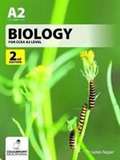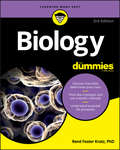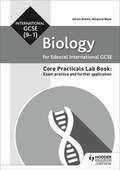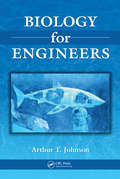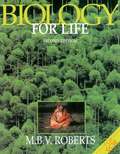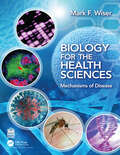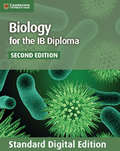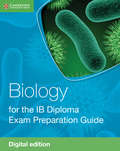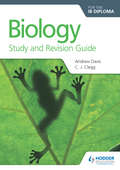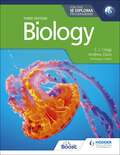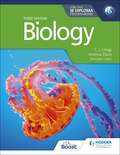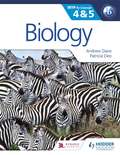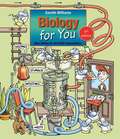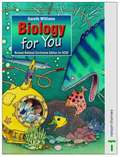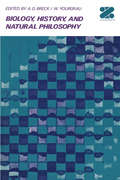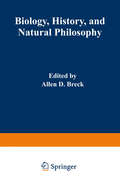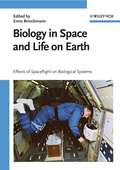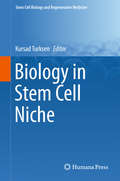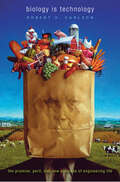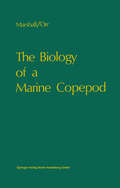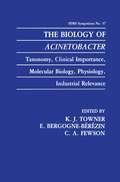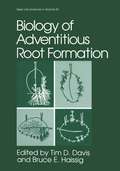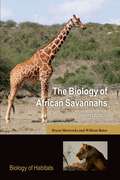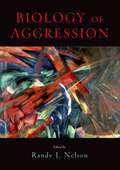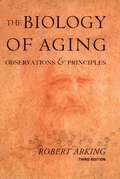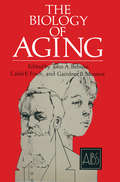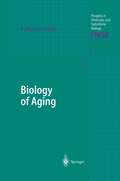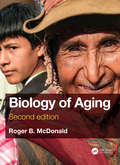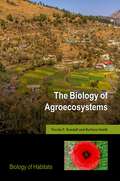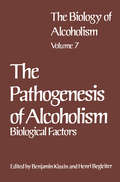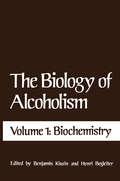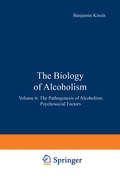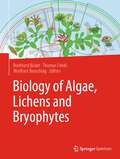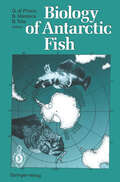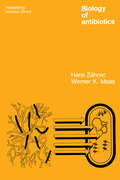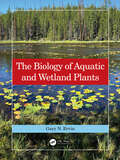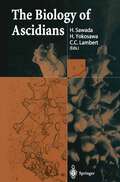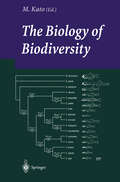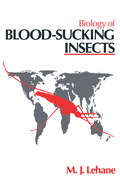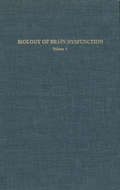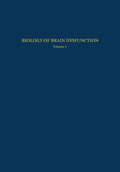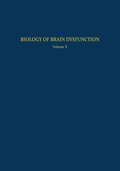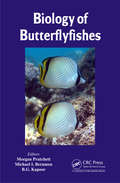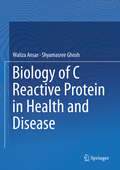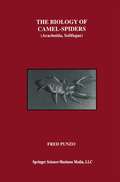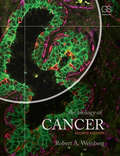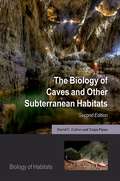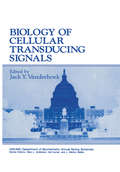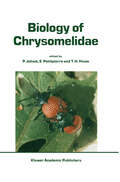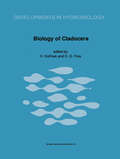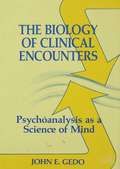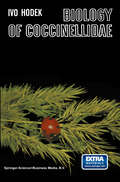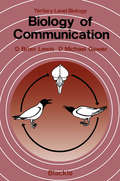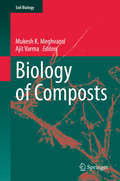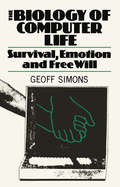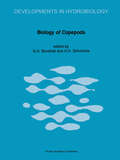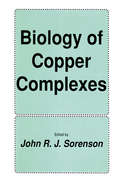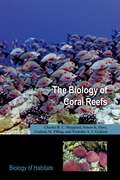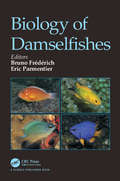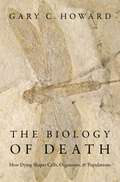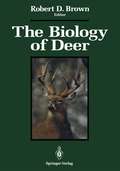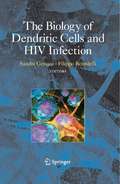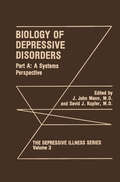- Table View
- List View
The Biology and Technology of Intelligent Autonomous Agents (NATO ASI Subseries F: #144)
by Luc SteelsThe NATO sponsored Advanced Study Institute 'The Biology and Tech nology of Intelligent Autonomous Agents' was an extraordinary event. For two weeks it brought together the leading proponents of the new behavior oriented approach to Artificial Intelligence in Castel Ivano near Trento. The goal of the meeting was to establish a solid scientific and technological foun dation for the field of intelligent autonomous agents with a bias towards the new methodologies and techniques that have recently been developed in Ar tificial Intelligence under the strong influence of biology. Major themes of the conference were: bottom-up AI research, artificial life, neural networks and techniques of emergent functionality. The meeting was such an extraordinary event because it not only featured very high quality lectures on autonomous agents and the various fields feeding it, but also robot laboratories which were set up by the MIT AI laboratory (with a lab led by Rodney Brooks) and the VUB AI laboratory (with labs led by Tim Smithers and Luc Steels). This way the participants could also gain practical experience and discuss in concreto what the difficulties and achievements were of different approaches. In fact, the meeting has been such a success that a follow up meeting is planned for September 1995 in Monte Verita (Switzerland). This meeting is organised by Rolf Pfeifer (University of Zurich).
Biology and the Mechanics of the Wave-Swept Environment (PDF)
by Mark DennyThis text introduces and draws together pertinent aspects of fluid dynamics, physical oceanography, solid mechanics, and organismal biology to provide a much-needed set of tools for quantitatively examining the biological effects of ocean waves. "Nowhere on earth does water move as violently as on wave-swept coasts," writes the author, "and every breaker that comes pounding on the shore places large hydrodynamic forces on the organisms resident there." Yet wave-swept coral reefs and rocky shores are home to some of the world's most diverse assemblages of plants and animals, and scientists have chosen these environments to carry out much of the recent experimental work in community structure and population dynamics. Until now these studies have been hampered because biologists often lack a working understanding of the mechanics of the wave-swept shore. Mark Denny here supplies that understanding in clear and vivid language.Included are an introduction to wave-induced water motions and the standard theories for describing them, a broad introduction to the hydrodynamic forces these water movements place on plants and animals, and an explanation of how organisms respond to these forces. These tools are put to use in the final chapters in an examination of the mechanisms of "wave exposure" and an exploration of the mechanical determinants of size and shape in wave-swept environments.Originally published in 1988.The Princeton Legacy Library uses the latest print-on-demand technology to again make available previously out-of-print books from the distinguished backlist of Princeton University Press. These editions preserve the original texts of these important books while presenting them in durable paperback and hardcover editions. The goal of the Princeton Legacy Library is to vastly increase access to the rich scholarly heritage found in the thousands of books published by Princeton University Press since its founding in 1905.
The Biology and Therapeutic Application of Mesenchymal Cells
by Kerry AtkinsonThe Biology and Therapeutic Application of Mesenchymal Cells comprehensively describes the cellular and molecular biology of mesenchymal stem cells and mesenchymal stromal cells, describing their therapeutic potential in a wide variety of preclinical models of human diseases and their mechanism of action in these preclinical models. Chapters also discuss the current status of the use of mesenchymal stem and stromal cells in clinical trials in a wide range of human diseases and disorders, for many of which there are limited, or no other, therapeutic avenues. Provides coverage on both the biology of mesenchymal stem cells and stromal cells, and their therapeutic applications Describes the therapeutic potential of mesenchymal stem and stromal cells in a wide variety of preclinical models of human diseases and their mechanism of action in these preclinical models Discusses the current status of mesenchymal stem and stromal cells in clinical trials in a wide range of human diseases and disorders, for many of which there are limited, or no other, therapeutic avenues Written and edited by leaders in the field The Biology and Therapeutic Application of Mesenchymal Cells is an invaluable resource for those studying stem cells, cell biology, genetics, gene or cell therapy, or regenerative medicine.
The Biology and Therapeutic Application of Mesenchymal Cells, 2 Volume Set
by Kerry AtkinsonThe Biology and Therapeutic Application of Mesenchymal Cells comprehensively describes the cellular and molecular biology of mesenchymal stem cells and mesenchymal stromal cells, describing their therapeutic potential in a wide variety of preclinical models of human diseases and their mechanism of action in these preclinical models. Chapters also discuss the current status of the use of mesenchymal stem and stromal cells in clinical trials in a wide range of human diseases and disorders, for many of which there are limited, or no other, therapeutic avenues. Provides coverage on both the biology of mesenchymal stem cells and stromal cells, and their therapeutic applications Describes the therapeutic potential of mesenchymal stem and stromal cells in a wide variety of preclinical models of human diseases and their mechanism of action in these preclinical models Discusses the current status of mesenchymal stem and stromal cells in clinical trials in a wide range of human diseases and disorders, for many of which there are limited, or no other, therapeutic avenues Written and edited by leaders in the field The Biology and Therapeutic Application of Mesenchymal Cells is an invaluable resource for those studying stem cells, cell biology, genetics, gene or cell therapy, or regenerative medicine.
The Biology and Troubleshooting of Facultative Lagoons (Wastewater Microbiology #7)
by Michael H. GerardiProvides personnel a new understanding of how lagoon and fixed film sewage treatment systems work Tested in short-course situations by the author over the last 20 years Directs the material in a practical manner at operators who are responsible for process control and troubleshooting Reduces the jargon, chemical equations, and kinetics that overwhelm most operators and laboratory technicians Provides necessary information for understanding biological and chemical conditions at the treatment process
The Biology and Troubleshooting of Facultative Lagoons: Biology And Troubleshooting Of Facultative Lagoons (Wastewater Microbiology)
by Michael H. GerardiProvides personnel a new understanding of how lagoon and fixed film sewage treatment systems work Tested in short-course situations by the author over the last 20 years Directs the material in a practical manner at operators who are responsible for process control and troubleshooting Reduces the jargon, chemical equations, and kinetics that overwhelm most operators and laboratory technicians Provides necessary information for understanding biological and chemical conditions at the treatment process
Biology As Ideology: The Doctrine of DNA (The CBC Massey Lectures)
by Richard LewontinR. C. Lewontin is a prominent scientist -- a geneticist who teaches at Harvard -- yet he believes that we have placed science on a pedestal, treating it as an objective body of knowledge that transcends all other ways of knowing and all other endeavours.Lewontin writes in this collection of essays, which began their life as CBC Radio's Massey Lectures Series for 1990: "Scientists do not begin life as scientists, after all, but as social beings immersed in a family, a state, a productive structure, and they view nature through a lens that has been molded by their social experience… . Science, like the Church before it, is a supremely social institution, reflecting and reinforcing the dominant values and vices of society at each historical epoch."In Biology as Ideology Lewontin examines the false paths down which modern scientific ideology has led us. By admitting science's limitations, he helps us rediscover the richness of nature -- and appreciate the real value of science.
Biology as Society, Society as Biology: Metaphors (Sociology of the Sciences Yearbook #18)
by Sabine Maasen E. Mendelsohn P. Weingartnot lie in the conceptual distinctions but in the perceived functions of metaphors and whether in the concrete case they are judged positive or negative. The ongoing debates reflect these concerns quite clearly~ namely that metaphors are judged on the basis of supposed dangers they pose and opportunities they offer. These are the criteria of evaluation that are obviously dependent on the context in which the transfer of meaning occurs. Our fundamental concern is indeed the transfer itself~ its prospects and its limits. Looking at possible functions of metaphors is one approach to under standing and elucidating sentiments about them. The papers in this volume illustrate, by quite different examples, three basic functions of metaphors: illustrative, heuristic~ and constitutive. These functions rep resent different degrees of transfer of meaning. Metaphors are illustrative when they are used primarily as a literary device, to increase the power of conviction of an argument, for example. Although the difference between the illustrative and the heuristic function of metaphors is not great, it does exist: metaphors are used for heuristic purposes whenever "differences" of meaning are employed to open new perspectives and to gain new insights. In the case of "constitutive" metaphors they function to actually replace previous meanings by new ones. Sabine Maasen in her paper introduces the distinction between transfer and transforma tion.
Biology at a Glance
by Judy DoddsThis book presents in a clear visual way the biology material needed for the Science and Additional Science GCSE, and for the separate Biology GCSE. It also serves as an introductory guide for AS Biology. It is illustrated throughout with photos and flow charts, with questions on every topic, Internet research activities and a glossary of words to
Biology at a Glance
by Judy DoddsThe fourth edition of a bestseller, this book presents, in a clear, concise, and visual way, the main biological content required by all the examining boards for both the GCSE Double Award Science and separate Biology Award, including IGCSE. It is also useful as an introductory guide for AS Biology. The fourth edition has been revised to include new material on industrial fermenters and their applications, plus additional material on flowering plants.
Biology class 10 - SCERT - Kerala Board: ജീവശാസ്ത്രം മലയാളം മീഡിയം ക്ലാസ് 10 എസ്.ഇ.ആര്.ടി കേരള ബോര്ഡ്
by Kerala ScertBiology Malayalam Medium Class 10 SCERT Kerala Board 1 is divided into four parts. The lessons cover sense organs, brain and nervous systems, hormones and their actions and finally the diseases and reasons. The topics are presented with detailed illustraions and images and tables.
Biology class 12 - NCERT
by National Council of Educational Research and TrainingThe Class XII Biology textbook deals with the physiological process of reproduction in flowering plants and humans, the principles of inheritance, the nature of genetic material and its function, the contributions of biology to human welfare, basic principles of biotechnological processes and their applications and achievements.
Biology class 9 - MIE
by Mauritius Institute of EducationThe Grade 9 Biology textbook from the Mauritius Institute of Education covers four comprehensive units. The first unit delves into the intricacies of the human Blood Circulatory System, exploring the structure and functions of blood, the heart, and blood vessels. It addresses topics like blood cell types, pulse, and cardiovascular diseases. The Reproduction unit explores both asexual and sexual reproduction in living organisms, detailing the structures and functions of human male and female reproductive systems, fertilization, embryo development, and the significance of reproductive health. The Biodiversity unit introduces the concept's importance for survival, explaining how to estimate species using quadrats and addressing factors affecting biodiversity. The final unit, Nutrition in Plants, delves into photosynthesis, emphasizing factors like light, carbon dioxide, water, and chlorophyll, and includes practical demonstrations on starch presence in leaves.
Biology, Computing, and the History of Molecular Sequencing: From Proteins to DNA, 1945-2000 (Science, Technology and Medicine in Modern History)
by M. García-SanchoSequencing is often associated with the Human Genome Project and celebrated achievements concerning the DNA molecule. However, the history of this practice comprises not only academic biology, but also the world of computer-assisted information management. The book uncovers this history, qualifying the hype and expectations around genomics.
Biology, Conservation and Sustainable Development of Sturgeons (Fish & Fisheries Series #29)
by Ramón Carmona José Antonio Hernando Fernando Rodríguez Manuel Ruiz-Rejón Alberto Domezain Manuel García GallegoSturgeons are considered “living fossils”, sharing many morphological and biological features with ancestral fish. Furthermore, sturgeons are of the utmost interest from an economic perspective, not only for the caviar but for the flesh. However, the wild populations of the majority of the species are at serious risk of extinction all over the world. So, it is urgent to develop strategies for both farming culture and conservation and recovery in natural habitats. This book provides a comprehensive view of the biology and sustainable development of sturgeons putting emphasis on the Southern Europe autochthonous species such as Acipenser nacarii and Acipenser sturio that share geographical distribution. Other relevant species (such as Huso huso, A. oxyrhinchus, A. ruthenus, A. stellatus) and areas (Germany, Russia, North America) are also considered. The contents are organised in three sections: Taxonomy and Biogeography (including the morphological and genetic analyses that clarify the taxonomy and phylogeny of sturgeons, focused on those from Southern Europe), Biology and Aquaculture (where several aspects of the developmental biology, feeding, and reproduction are considered in relation to the improvement of sturgeon farming), and Recovery and Conservation (that collates and analyses different recovery research actions, the ecology of the rivers for restoration as well as the problems related to the trade of caviar).
Biology, Controls and Models of Tree Volatile Organic Compound Emissions (Tree Physiology #5)
by Ülo Niinemets and Russell K. MonsonPlant-driven volatile organic compound (BVOC) emissions play a major role in atmospheric chemistry, including ozone and photochemical smog formation in the troposphere, and they extend the atmospheric lifetime of the key greenhouse gas, methane. Furthermore, condensation of photo-oxidation products of BVOCs leads to formation of secondary organic aerosols with profound implications for the earth's solar radiation budget and climate. Trees represent the plant life form that most contributes to BVOC emissions, which gives global forests a unique role in regulating atmospheric chemistry.Written by leading experts in the field, the focus is on recent advancements in understanding the controls on plant-driven BVOC emissions, including efforts to quantitatively predict emissions using computer models, particularly on elicitation of emissions under biotic and abiotic stresses, molecular mechanisms of volatile synthesis and emission and the role of emissions in plant stress tolerance.
Biology Course Companion: Oxford IB Diploma Programme (PDF)
by Andrew Allott David MindorffThe only DP Biology resource developed with the IB to accurately match the new 2014 syllabus for both SL and HL, this completely revised edition gives you unparallelled support for the new concept-based approach to learning, the Nature of science. Understanding, applications and skills are integrated in every topic, alongside TOK links and real-world connections to drive inquiry and independentlearning. Assessment support directly from the IB includes practice questions and worked examples in each topic, along with focused support for the Internal Assessment.
Biology Course Companion: Oxford IB Diploma Programme (PDF)
by Andrew Allott David MindorffThe only DP Biology resource developed with the IB to accurately match the new 2014 syllabus for both SL and HL, this completely revised edition gives you unparallelled support for the new concept-based approach to learning, the Nature of science. Understanding, applications and skills are integrated in every topic, alongside TOK links and real-world connections to drive inquiry and independentlearning. Assessment support directly from the IB includes practice questions and worked examples in each topic, along with focused support for the Internal Assessment.
Biology, Ecology and Culture of Grey Mullets (Mugilidae)
by Donatella Crosetti Stephen J. M. BlaberMullets (grey mullets) are a family (Mugilidae) and order of ray-finned fish found in temperate and tropical waters worldwide. There are approximately 80 species of mullet; these fish have been considered an important food source in Mediterranean Europe since Roman times. This book provides a long overdue update on the biology and ecology of mullet
Biology, Ecology and Management of Aquatic Plants: Proceedings of the 10th International Symposium on Aquatic Weeds, European Weed Research Society (Developments in Hydrobiology #147)
by Ilidio S. Moreira Kevin J. Murphy Philip Max Wade Joseph Caffrey Philip R. F. Barrett Maria Teresa FerreiraThere is a growing need for appropriate management of aquatic plants in rivers and canals, lakes and reservoirs, and drainage channels and urban waterways. This management must be based on a sound knowledge of the ecology of freshwater plants, their distribution and the different forms of control available including chemical and physical, and biological and biomanipulation. This series of papers from over 20 different countries was generated from the tenth in the highly successful series of European Weed Research Society symposia on aquatic plant management, this being the tenth. It provides a valuable insight into the complexities involved in managing aquatic systems, discusses state-of-the-art control techniques and deals with patterns of regrowth and recovery post-management. Careful consideration is given to the use of chemicals, a practice which has come under scrutiny in recent years. Underpinning the development of such control techniques is a growing body of knowledge relating to the biology and ecology of water plants. The authorship of the papers represents the collective wisdom of leading scientists and experts from fisheries agencies, river authorities, nature conservation agencies, the agrochemical industry and both governmental and non-governmental organisations.
Biology Education and Research in a Changing Planet: Selected Papers from the 25th Biennial Asian Association for Biology Education Conference
by Esther Gnanamalar Sarojini DanielThis book presents selected conference proceedings from the 25th Biennial Asian Association for Biology Education Conference. It clarifies the differences between the structure of biology education for educators and researchers. It solves open problems by creating a bridge between biological research and its application in education and the sustainable development of communities. The book’s first topic is Biology Education in an X, Y, Z World, which provides ideas for how biology can be taught in innovative ways. The second topic, The Endangered Planet – How can Biology Education Help? discusses how humans depend on other species for survival and how they have the power to cause or to prevent extinctions. The third and final topic, Research in Biology, encompasses the growing wealth of biological information resulting from scientific research, especially in universities. Educators can use these findings to enhance their teaching.
Biology Essentials For Dummies
by Rene Fester Kratz Donna Rae SiegfriedBiology Essentials For Dummies (9781119589587) was previously published as Biology Essentials For Dummies (9781118072677). While this version features a new Dummies cover and design, the content is the same as the prior release and should not be considered a new or updated product. Just the core concepts you need to score high in your biology course Biology Essentials For Dummies focuses on just the core concepts you need to succeed in an introductory biology course. From identifying the structures and functions of plants and animals to grasping the crucial discoveries in evolutionary, reproductive, and ecological biology, this easy-to-follow guide lets you skip the suffering and score high at exam time. Get down to basics — master the fundamentals, from understanding what biologists study to how living things are classified The chemistry of life — find out what you need to know about atoms, elements, molecules, compounds, acids, bases, and more Conquer and divide — discover the ins and outs of asexual and sexual reproduction, including cell division and DNA replication Jump into the gene pool — grasp how proteins make traits happen, and easily understand DNA transcription, RNA processing, translation, and gene regulation.
Biology Essentials For Dummies
by Rene Fester Kratz Donna Rae SiegfriedBiology Essentials For Dummies (9781119589587) was previously published as Biology Essentials For Dummies (9781118072677). While this version features a new Dummies cover and design, the content is the same as the prior release and should not be considered a new or updated product. Just the core concepts you need to score high in your biology course Biology Essentials For Dummies focuses on just the core concepts you need to succeed in an introductory biology course. From identifying the structures and functions of plants and animals to grasping the crucial discoveries in evolutionary, reproductive, and ecological biology, this easy-to-follow guide lets you skip the suffering and score high at exam time. Get down to basics — master the fundamentals, from understanding what biologists study to how living things are classified The chemistry of life — find out what you need to know about atoms, elements, molecules, compounds, acids, bases, and more Conquer and divide — discover the ins and outs of asexual and sexual reproduction, including cell division and DNA replication Jump into the gene pool — grasp how proteins make traits happen, and easily understand DNA transcription, RNA processing, translation, and gene regulation.
Biology Exam Practice For CCEA A2 Level
by James NapierThis workbook contains practice questions of examination standard for the current CCEA A2 Biology specification. Ideal for revision or to reinforce knowledge. Full answers, marking scheme, tips on common errors and how to maximise marks are available via this link: http://colourpointeducational.com/media/content/A2BiologyExamPracticeMarkScheme.pdf All questions were specially commissioned for this book and are not from past papers. The workbook also contains an introductory section with tips and advice on examination technique. The author, Dr James Napier, is a well-known Biology author who, prior to his recent retirement, was vice-principal in a Northern Ireland grammar school.
Biology Exam Practice for CCEA AS Level
by Dr James NapierWorkbook containing practice questions of examination standard for the current CCEA AS Biology specification. Ideal for revision or to reinforce knowledge. Full answers and mark scheme available online via this link: http://colourpointeducational.com/media/content/ASBiologyExamPracticeMarkScheme.pdf All questions were specially commissioned for this book and are not from past papers. The workbook also contains an introductory section with tips and advice on examination technique. The author, Dr James Napier, is a well-known Biology author who, prior to his recent retirement, was vice-principal in a Northern Ireland grammar school.
Biology for Cambridge iGCSE: Revision Guide (PDF)
by Ron PickeringThe Oxford Revision Guides series builds on the fact that pictures are easier to memorise than words. Each topic is summarised on a single page using annotated diagrams and concise notes with a full index for easy reference. Students will save valuable revision time by using these notesinstead of condensing their own. In fact, many students are choosing to buy their own copies so they can colour code or highlight them as they might do their own revision notes.
Biology for Cambridge IGCSE (International Secondary) (PDF)
by Janet Adams Gareth Williams Lawrie Ryan Richard FosberyBiology for Cambridge IGCSE is endorsed by Cambridge International Examinations and matches specification 0610. It is written by a team of experienced authors and examiners and is ideal for international school students. Features include an exam focus with exam-style questions, activities, case studies, key points amp; 'Did you know?' sections.
Biology for CCEA A2 Level (PDF)
by James NapierThis popular resource has been comprehensively updated to cover the revised CCEA A2 level Biology specification. Following the same content as the specification, the book is presented in full colour with over two hundred illustrations. This bright and clear layout will aid students’ understanding of the course. Sample examination questions are also provided throughout to reinforce learning and aid preparation for the exam. New material addressing the practical work in the A2 3 paper has been added to this edition. Contents A2 1 Physiology, Co-ordination and Control, and Ecosystems Chapter 1 – Homeostasis and the Kidney Chapter 2 – Immunity Chapter 3 – Coordination and Control in Plants Chapter 4 – Neurones and Synapses Chapter 5 – The Eye and Muscle Chapter 6 – Populations and Communities Chapter 7 – Ecological Energetics and Nutrient Cycling A2 2 Biochemistry, Genetics and Evolutionary Trends Chapter 8 – Respiration Chapter 9 – Photosynthesis Chapter 10 – DNA as the Genetic Code (Protein Synthesis) Chapter 11 – Gene Technology Chapter 12 – Genes and Patterns of Inheritance Chapter 13 – Population Genetics Chapter 14 – The Plant and Animal Kingdoms Chapter 15 – Statistics The author, Dr James Napier, is a well-known Biology author and a former teacher in a Northern Ireland Grammar School.
Biology For Dummies
by Rene Fester KratzThe ultimate guide to understanding biology Have you ever wondered how the food you eat becomes the energy your body needs to keep going? The theory of evolution says that humans and chimps descended from a common ancestor, but does it tell us how and why? We humans are insatiably curious creatures who can't help wondering how things work—starting with our own bodies. Wouldn't it be great to have a single source of quick answers to all our questions about how living things work? Now there is. From molecules to animals, cells to ecosystems, Biology For Dummies answers all your questions about how living things work. Written in plain English and packed with dozens of enlightening illustrations, this reference guide covers the most recent developments and discoveries in evolutionary, reproductive, and ecological biology. It's also complemented with lots of practical, up-to-date examples to bring the information to life. Discover how living things work Think like a biologist and use scientific methods Understand lifecycle processes Whether you're enrolled in a biology class or just want to know more about this fascinating and ever-evolving field of study, Biology For Dummies will help you unlock the mysteries of how life works.
Biology For Dummies
by Rene Fester KratzThe ultimate guide to understanding biology Have you ever wondered how the food you eat becomes the energy your body needs to keep going? The theory of evolution says that humans and chimps descended from a common ancestor, but does it tell us how and why? We humans are insatiably curious creatures who can't help wondering how things work—starting with our own bodies. Wouldn't it be great to have a single source of quick answers to all our questions about how living things work? Now there is. From molecules to animals, cells to ecosystems, Biology For Dummies answers all your questions about how living things work. Written in plain English and packed with dozens of enlightening illustrations, this reference guide covers the most recent developments and discoveries in evolutionary, reproductive, and ecological biology. It's also complemented with lots of practical, up-to-date examples to bring the information to life. Discover how living things work Think like a biologist and use scientific methods Understand lifecycle processes Whether you're enrolled in a biology class or just want to know more about this fascinating and ever-evolving field of study, Biology For Dummies will help you unlock the mysteries of how life works.
Biology For Edexcel International GCSE: Core Practicals Lab Book - Exam Practice and Further Application
by Adrian Schmit Margaret RoyalProvide full coverage of the required practicals and build students' working scientifically skills with questions that enable them to apply their knowledge to new contexts. - Extend knowledge and build working scientifically skills with 'Further Application' sections that provide additional questions to allow students to practice applying their knowledge. - Help guide students through the practical, the analysis of results, and generating a reasoned conclusion with scaffolded questions. - Get exam ready with exam-style questions, guidance on how practicals are assessed, a list of useful equations, and a checklist to monitor progress. - Cover all the required practicals with methods provided, complete with safety notes and guidance on equipment.
Biology for Engineers
by Arthur T. JohnsonBiology is a critical application area for engineering analysis and design, and students in engineering programs must be well-versed in the fundamentals of biology as they relate to their field. Biology for Engineers is an introductory text that minimizes unnecessary memorization of connections and classifications and instead emphasizes concepts, t
Biology for Life (2nd edition)
by Roberts, Michael Bliss VaughnBiology for Life is the leading text for 14-16 year olds in Caribbean schools. This flexible, attractive text is clear and easy to read, providing material for a wide range of abilities. Biology for life contains practical investigations which give clear instructions, and allow students to work independently of the teacher.
Biology for Life (2nd edition) (PDF)
by Roberts Michael Bliss VaughnBiology for Life is the leading text for 14-16 year olds in Caribbean schools. This flexible, attractive text is clear and easy to read, providing material for a wide range of abilities. Biology for life contains practical investigations which give clear instructions, and allow students to work independently of the teacher.
Biology for the Health Sciences: Mechanisms of Disease
by Mark F WiserBiology is central to our understanding of health and disease and to the development of effective treatments, and thus it is critical that health professionals have a solid grounding and knowledge comfort in the pathogenesis and mechanisms of disease processes. This innovative new textbook draws these topics together, providing an accessible introduction across four central disciplines - basic biology, biotechnology, non-infectious disease and infectious disease. Key Features: Provides students of biology and those going into health care professions with a strong foundation to understand the pathogenesis of disease at the molecular and cellular level Focuses on the etiology and pathophysiology of the major human diseases by body system, including diabetes and nutritional disorders, cardiovascular disease, neurodegenerative diseases, and cancer, aligned to medicine and health science course structure Covers mechanisms of infectious disease transmission, as well as disease pathophysiology, and considers the impact of antibiotic resistance Reviews the applications of biotechnology and genomics to human health in diagnosis and treatment, as well as to our understanding of disease and disease surveillance Each chapter contains a mini glossary of key terms and associated definitions, and review questions allow students to assess how much of the chapter they have understood Digital resources accompany the textbook, such as interactive quizzes for students to engage with and figure slides of the book's illustrations that instructors can use in lectures Enhanced throughout with plentiful illustrations, Biology for the Health Sciences is an essential companion for any student of the health sciences and for biological science students studying the causes of disease as part of a wider course.
Biology for the Health Sciences: Mechanisms of Disease
by Mark F WiserBiology is central to our understanding of health and disease and to the development of effective treatments, and thus it is critical that health professionals have a solid grounding and knowledge comfort in the pathogenesis and mechanisms of disease processes. This innovative new textbook draws these topics together, providing an accessible introduction across four central disciplines - basic biology, biotechnology, non-infectious disease and infectious disease. Key Features: Provides students of biology and those going into health care professions with a strong foundation to understand the pathogenesis of disease at the molecular and cellular level Focuses on the etiology and pathophysiology of the major human diseases by body system, including diabetes and nutritional disorders, cardiovascular disease, neurodegenerative diseases, and cancer, aligned to medicine and health science course structure Covers mechanisms of infectious disease transmission, as well as disease pathophysiology, and considers the impact of antibiotic resistance Reviews the applications of biotechnology and genomics to human health in diagnosis and treatment, as well as to our understanding of disease and disease surveillance Each chapter contains a mini glossary of key terms and associated definitions, and review questions allow students to assess how much of the chapter they have understood Digital resources accompany the textbook, such as interactive quizzes for students to engage with and figure slides of the book's illustrations that instructors can use in lectures Enhanced throughout with plentiful illustrations, Biology for the Health Sciences is an essential companion for any student of the health sciences and for biological science students studying the causes of disease as part of a wider course.
Biology for the IB Diploma (IB Diploma)
by Brenda WalpoleBiology for the IB Diploma, Second edition covers in full the requirements of the IB syllabus for Biology for first examination in 2016. The second edition of this well-received Coursebook is fullly updated for the IB Biology syllabus for first examination in 2016, comprehensively covering all requirements. Get the best coverage of the syllabus with clear assessment statements, and links to Theory of Knowledge, International-mindedness and Nature of Science themes. Exam preparation is supported with plenty of sample exam questions, online test questions and exam tips. Chapters covering the Options and Nature of Science, assessment guidance and answers to questions are included in the free online material available with the book.
Biology for the IB Diploma Exam Preparation Guide Digital Edition (IB Diploma)
by Brenda WalpoleThis Exam Preparation Guide offers support for students as they prepare for their IB Diploma Biology exams. Containing up-to-date material that matches the new 2016 IB diploma syllabus and packed full of guidance specifically designed to help students apply their knowledge in exams such as Model Answers, Annotated Exemplar Answers, Worked Examples and hints throughout to help students hone their revision and exam technique and avoid common mistakes. Written in an engaging and student friendly tone, this Exam Preparation Guide is perfect for international learners.
Biology for the IB Diploma Study and Revision Guide
by Andrew Davis C. J. CleggStretch your students to achieve their best grade with these year round course companions; providing clear and concise explanations of all syllabus requirements and topics, and practice questions to support and strengthen learning. - Consolidate revision and support learning with a range of exam practice questions and concise and accessible revision notes- Practise exam technique with tips and trusted guidance from examiners on how to tackle questions- Focus revision with key terms and definitions listed for each topic/sub topic
Biology for the IB Diploma Third edition
by C. J. Clegg Andrew DavisDeveloped in cooperation with the International Baccalaureate®Trust experienced and best-selling authors to navigate the new syllabuses confidently with these coursebooks that implement inquiry-based and conceptually-focused teaching and learning.- Ensure a continuum approach to concept-based learning through active student inquiry; our authors are not only IB Diploma experienced teachers but are also experienced in teaching the IB MYP and have collaborated on our popular MYP by Concept series. - Build the skills and techniques covered in the Tools (Experimental techniques, Technology and Mathematics) with direct links to the relevant parts of the syllabus; these skills also provide the foundation for practical work and internal assessment.- Integrate Theory of Knowledge into your lessons with TOK boxes and Inquiries that provide real-world examples, case studies and questions. The TOK links are written by the author of our bestselling TOK coursebook, John Sprague and Paul Morris, our MYP by Concept series and Physics co-author.- Develop approaches to learning with ATL skills identified and developed with a range of engaging activities with real-world applications. - Explore ethical debates and how scientists work in the 21st century with Nature of Science boxes throughout. - Help build international mindedness by exploring how the exchange of information and ideas across national boundaries has been essential to the progress of science and illustrates the international aspects of science. - Consolidate skills and improve exam performance with short and simple knowledge-checking questions, exam-style questions, and hints to help avoid common mistakes.
Biology for the IB Diploma Third edition
by C. J. Clegg Andrew DavisDeveloped in cooperation with the International Baccalaureate®Trust experienced and best-selling authors to navigate the new syllabuses confidently with these coursebooks that implement inquiry-based and conceptually-focused teaching and learning.- Ensure a continuum approach to concept-based learning through active student inquiry; our authors are not only IB Diploma experienced teachers but are also experienced in teaching the IB MYP and have collaborated on our popular MYP by Concept series. - Build the skills and techniques covered in the Tools (Experimental techniques, Technology and Mathematics) with direct links to the relevant parts of the syllabus; these skills also provide the foundation for practical work and internal assessment.- Integrate Theory of Knowledge into your lessons with TOK boxes and Inquiries that provide real-world examples, case studies and questions. The TOK links are written by the author of our bestselling TOK coursebook, John Sprague and Paul Morris, our MYP by Concept series and Physics co-author.- Develop approaches to learning with ATL skills identified and developed with a range of engaging activities with real-world applications. - Explore ethical debates and how scientists work in the 21st century with Nature of Science boxes throughout. - Help build international mindedness by exploring how the exchange of information and ideas across national boundaries has been essential to the progress of science and illustrates the international aspects of science. - Consolidate skills and improve exam performance with short and simple knowledge-checking questions, exam-style questions, and hints to help avoid common mistakes.
Biology for the IB MYP 4 & 5: By Concept (PDF)
by Andrew DavisEndorsed by the IB Drive meaningful inquiry through a unique concept-driven narrative. - Supports every aspect of assessment with opportunities that use the criteria - Gives you easy ways to differentiate and extend learning - Provides a meaningful approach by integrating the inquiry statement in a global context - Develops critical-thinking skills with activities and summative sections rooted in the ATL framework This title is also available in two digital formats via Dynamic Learning. Find out more by clicking on the links at the top of the page.
Biology for You: Fifth Edition For All Gcse Examinations
by Gareth WilliamsCovering all GCSE specifications, this tried and tested series has been fully updated to match the (9-1) GCSE Biology specifications for first examination in 2018, as well as international specifications. With a focus on science, concepts develop naturally, engaging students and enabling them to get a thorough understanding of Biology.
Biology for You (Revised National Curriculum Edition for GCSE): Textbook (PDF)
by Gareth Williams Nick PaulThe most popular textbook for GCSE Co-ordinated Science syllabuses. Using a highly motivational and accessible style of material presentation, the book is written to encourage a wide range of students to achieve success at GCSE. Single and Double Science can be taught separately, with options being clearly marked.
Biology, History, and Natural Philosophy
by Allen D. Breck and Wolfgang YourgrauIn a world that peers over the brink of disaster more often than not it is difficult to find specific assignments for the scholarly community. One speaks of peace and brotherhood only to realize that for many the only real hope of making a contribution may seem to be in a field of scientific specialization seemingly irrelevant to social causes and problems. Yet the history of man since the beginnings of science in the days of the Greeks does not support this gloomy thesis. Time and again we have seen science precipitate social trends or changes in the humanistic beliefs that have a significant effect on the scientific community. Not infrequently the theoretical scientist, triggered by society's changing goals and understandings, finds ultimate satisfaction in the work of his colleagues in engineering and the other applied fields. Thus the major debate in mid-nineteenth century in which the evidence of natural history and geology at variance with the Biblical feats provided not only courage to a timid Darwin but the kind of audience that was needed to fit his theories into the broad public dialogue on these topics. The impact of "Darwinism" was felt far beyond the scientific community. It affected social thought, upset religious certainties and greatly affected the teaching of science.
Biology, History, and Natural Philosophy: Based on the Second International Colloquium held at the University of Denver
by Allen D. Breck and Wolfgang YourgrauIn a world that peers over the brink of disaster more often than not it is difficul t to find specific assignments for the scholarly community. One speaks of peace and brotherhood only to realize that for many the only real hope of making a contribution may seem to be in a field of scientific specialization seemingly irrelevant to social causes and problems. Yet the history of man since the beginnings of science in the days of the Greeks does not support this gloomy thesis. Time and again we have seen science precipitate social trends or changes in the humanistic beliefs that have a significant effect on. the scientific community. Not infrequently the theoretical scientist, triggered by society's changing goals and understandings, finds ultimate satisfaction in the work of his colleagues in engineering and the other applied fields. Thus the major debate in mid-nineteenth century in which the evidence of natural history and geology at variance with the Biblical feats provided not only courage to a timid Darwin but the kind of audience that was needed to fit his theories into the broad public dialogue on these topics. The impact of "Darwinism" was felt far beyond the scientific community. It affected social thought, upset religious certainties and greatly affected the teaching of science.
Biology in Space and Life on Earth: Effects of Spaceflight on Biological Systems
by Enno BrinckmannThis concise yet comprehensive treatment of the effects of spaceflight on biological systems includes issues at the forefront of life sciences research, such as gravitational biology, immune system response, bone cell formation and the effects of radiation on biosystems. Edited by a leading specialist at the European Space Agency (ESA) with contributions by internationally renowned experts, the chapters are based on the latest space laboratory experiments, including those on SPACELAB, ISS, parabolic flights and unmanned research satellites. An indispensable source for biologists, medical researchers and astronautics experts alike. The results of Space flight experiments, ground controls and flight simulations pave the way for a better understanding of gravity reactions in various organisms down to molecular mechanisms. This publication marks also the beginning of a new Space flight era with the construction and exploitation of the International Space Station (ISS) which provides a platform for an in-depth continuation of experiments under weightlessness in Low Earth Orbit and beyond.
Biology in Stem Cell Niche: Methods And Protocols (Stem Cell Biology and Regenerative Medicine #1035)
by Kursad TurksenThis comprehensive volume explores functions, pathologies, and applications of stem cells in relation to the niches in which they develop. Ten chapters cover the subject in depth, from a historical perspective through signaling, hormonal control, quiescence, biomimetics, epigenetics, engineering strategies for emulating, tumorigenesis and more. The chapter authors represent a broad range of international expertise and perspectives.This installment of the popular Stem Cell Biology and Regenerative Medicine series delivers authoritative, international perspectives on this rapidly growing field. Biology of Stem Cell Niche is an ideal complementary volume to Tissue-Specific Stem Cell Niche and Adult Stem Cells, Second Edition and will be invaluable to clinicians and researchers working with stem cells as well as to postgraduate trainees who are studying them.
Biology Is Technology: The Promise, Peril, and New Business of Engineering Life
by Robert H. CarlsonTechnology is a process and a body of knowledge as much as a collection of artifacts. Biology is no different—and we are just beginning to comprehend the challenges inherent in the next stage of biology as a human technology. It is this critical moment, with its wide-ranging implications, that Robert Carlson considers in Biology Is Technology. He offers a uniquely informed perspective on the endeavors that contribute to current progress in this area—the science of biological systems and the technology used to manipulate them. In a number of case studies, Carlson demonstrates that the development of new mathematical, computational, and laboratory tools will facilitate the engineering of biological artifacts—up to and including organisms and ecosystems. Exploring how this will happen, with reference to past technological advances, he explains how objects are constructed virtually, tested using sophisticated mathematical models, and finally constructed in the real world. Such rapid increases in the power, availability, and application of biotechnology raise obvious questions about who gets to use it, and to what end. Carlson’s thoughtful analysis offers rare insight into our choices about how to develop biological technologies and how these choices will determine the pace and effectiveness of innovation as a public good.
The Biology of a Marine Copepod: Calanus finmarchicus (Gunnerus)
by S. M. Marshall A. P. OrrWith a Selection of Papers on Calanus finmarchicus published since 1953
The Biology of Acinetobacter: Taxonomy, Clinical Importance, Molecular Biology, Physiology, Industrial Relevance (F.E.M.S. Symposium Series #57)
by K. J. Towner E. Bergogne-Bérézin C. A. FewsonThe 1st International Workshop on Acinetobacter was held on 6th September, 1986, in Manchester, England, in association with the 14th International Congress of Microbiology. That occasion was so well attended and productive that there were soon discussions about how, when and where the next meeting should be held. This time, however, there was sufficient confidence to think of a more substantial meeting and to plan for the proceedings to be published. It emerged that there was wide agreement that the time was ripe to take stock of the entire biology of Acinetobacter: its occurrence and taxonomy; its molecular biology, biochemistry and physiology; its clinical importance and its industrial and commercial applications. The 2nd International Workshop on Acinetobacter took place from 6th to 7th September, 1990, at the Institut Pasteur, Paris, and was sponsored by the Federation of European Microbiological Societies. There were about 100 participants from 19 countries. The backbone of the meeting consisted of 23 plenary lectures. There were 28 posters and the meeting closed with a general discussion which went on long after the official finishing time despite all the counter-attractions of a sunny Parisian Friday afternoon. Indeed discussions continued while cruising along the Seine and while dining at the top of the Tour Montparnasse. However, the vitality and usefulness of even the most successful meeting is difficult to transmit by the printed word.
Biology of Adventitious Root Formation (Basic Life Sciences #62)
by Tim D. Davis Bruce E. HaissigCharles E. Hess Department of Environmental Horticulture University of California Davis, CA 95616 Research in the biology of adventitious root formation has a special place in science. It provides an excellent forum in which to pursue fundamental research on the regulation of plant growth and development. At the same time the results of the research have been quickly applied by commercial plant propagators, agronomists, foresters and horticulturists (see the chapter by Kovar and Kuchenbuch, by Ritchie, and by Davies and coworkers in this volume). In an era when there is great interest in speeding technology transfer, the experiences gained in research in adventitious root formation may provide useful examples for other areas of science. Interaction between the fundamental and the applied have been and continue to be facilitated by the establishment, in 1951, of the Plant Propagators' Society, which has evolved into the International Plant Propagators' Society, with active programs in six regions around the world. It is a unique organization which brings together researchers in universities, botanical gardens and arboreta, and commercial plant propagators. In this synergistic environment new knowledge is rapidly transferred and new ideas for fundamental research evolve from the presentations and discussions by experienced plant propagators. In the past 50 years, based on research related to the biology of adventitious root formation, advances in plant propagation have been made on two major fronts.
The Biology of African Savannahs (Biology of Habitats)
by Bryan Shorrocks William BatesSavannah habitats comprise an ecologically important, but ultimately fragile, ecosystem. They constitute one of the largest biomes on Earth, covering almost 20% of the land surface, and can be simply described as tropical and subtropical grasslands with scattered bushes and trees. Most savannahs occur in Africa, although smaller areas can be found in South America, India, and Australia. They form a rich mosaic of diverse ecosystems, and this book offers a concise but comprehensive introduction to their ecology, biodiversity, and conservation. The Biology of African Savannahs describes the major plants (grasses, and trees such as Acacia) and animals (mainly large mammals) that live in this habitat, and examines the biological and ecological factors that influence their population size, interactions (such as predation), and community composition. Conservation issues such as climate change, hunting, and conflict between wildlife and domestic animals are also discussed. This new edition has been updated throughout with the latest research in the field, and contains new technique boxes which introduce readers to some of the analytical methods used to study African savannahs. This accessible text is suitable for both senior undergraduate and graduate students taking courses in savannah and tropical ecology as part of a wider ecology and/or conservation biology degree programme. It will also be of relevance and use to the many professional ecologists and conservation practitioners requiring a concise but authoritative overview of the topic.
Biology of Aggression
by Randy J. NelsonUnchecked aggression and violence take a significant toll on society. Even if we manage to avoid being the direct victim of a violent act, the effects of aggression and violence reach us all: We hear about the mauling of a woman by an aggressive dog, our children are bullied at school, or we deal with impulsive violence while commuting to work or attending a sporting event. Reflecting psychology in general, the dominant roles of learning and environmental influences - both social and nonsocial - have traditionally been prominent in discussions of the etiology of human aggression. Biological factors have not been considered sufficiently important to investigate in the search for ways of dealing with human aggression or violence. With recent advances in pharmacology and genetic manipulation techniques, however, new interest has developed in the biological mechanisms of both non-human and human aggression. Although aggression is certainly a complex social behavior with multiple causes, molecular biological factors should not be overlooked, as they may well lead to interventions that prevent excess aggressive behaviors. The primary goal of this book is to summarize and synthesize recent advances in the biological study of aggression. As most aggressive encounters among human and non-human animals represent a male proclivity, the research in this book describes and discusses studies using the most appropriate murine model: testosterone-dependent offensive inter-male aggression, which is typically measured in resident-intruder or isolation-induced aggression tests. The research also emphasizes various molecules that have been linked to aggression tests. The research also emphasizes various molecules that have been linked to aggression by the latest gene-targeting and pharmacological techniques. Although the evidence continues to point to androgens and serotonin (5-HT) as major hormonal and neurotransmitter factors in aggressive behavior, recent work with GABA, dopamine, vasopressin, and other factors, such as nitric oxide, has revealed significant interactions with the neural circuitry underlying aggression. This book is organized according to levels of analysis. The first section examines the genetic contributions to aggression in species ranging from crustaceans to humans. The section summarizes the involvement of various neurotransmitters and neuromodulators in aggressive behavior. The third section summarizes the influence of hormones on aggression, primarily in humans. All chapters emphasize future directions for research on aggression and reveal important domains that have received comparatively less attention in this literature. Considered together, these chapters provide up-to-date coverage of the biology of aggression by some of the leading authorities currently working in this field. Biology of Aggression will direct future research to continue the recent advances in the pharmacological and genetic approaches to understanding aggression and violence. It promises to be a valuable resource for professional and student researchers in neuroscience, psychiatry, cognitive and developmental psychology, behavioral biology, and veterinary medicine.
Biology of Aging: Observations and Principles
by Robert ArkingRobert Arking's Biology of Aging, 3rd edition, is an introductory text to the biology of aging which gives advanced undergraduate and graduate students a thorough review of the entire field. His prior two editions have also served admirably as a reference text for clinicians and scientists. This new edition captures the extraordinary recent advances in our knowledge of the ultimate and proximal mechanisms underlying the phenomenon of aging. As a result, six important conceptual changes are included here: · Clarified distinctions between the biological mechanisms involved in longevity determination and those involved in senescent processes. · A new conceptual framework around which we can organize all the new facts about aging. This will assist readers to make sense of the information and use the data to form their own ideas. · Increased knowledge of aging cells has lead to new ideas on how a cell transits from a healthy state to a senescent state, while still allowing for high levels of intra- and inter-specific variability. · Discussion of senescent mechanisms assists the reader to understand that aging is a non-programmatic loss of function, likely arising from the loss of regulatory signals, and so is modifiable in the laboratory. · Because the standard evolutionary story does not fully explain the evolution of social organisms, this edition also includes recent work dealing with intergenerational resource transfers. · Lastly, if aging mechanisms are plastic, then the demand to move these anti-aging interventions into the human arena will inevitably grow. A discussion of the biological and ethical arguments on both sides of the question frames the question in an appropriate manner. The mass of data related to aging is summarized into fifteen focused chapters, each dealing with some particular aspect of the problem. The last two chapters integrate all this material into a coherent view of how the relevant biological processes change over the life span. This view is expressed in two non-technical figures (you might say that the whole book exists to fully support Figs 9-4 & 14-9), whose meanings are elucidated as the reader progresses through the book.
Biology of Aging: Observations and Principles
by Robert ArkingRobert Arking's Biology of Aging, 3rd edition, is an introductory text to the biology of aging which gives advanced undergraduate and graduate students a thorough review of the entire field. His prior two editions have also served admirably as a reference text for clinicians and scientists. This new edition captures the extraordinary recent advances in our knowledge of the ultimate and proximal mechanisms underlying the phenomenon of aging. As a result, six important conceptual changes are included here: · Clarified distinctions between the biological mechanisms involved in longevity determination and those involved in senescent processes. · A new conceptual framework around which we can organize all the new facts about aging. This will assist readers to make sense of the information and use the data to form their own ideas. · Increased knowledge of aging cells has lead to new ideas on how a cell transits from a healthy state to a senescent state, while still allowing for high levels of intra- and inter-specific variability. · Discussion of senescent mechanisms assists the reader to understand that aging is a non-programmatic loss of function, likely arising from the loss of regulatory signals, and so is modifiable in the laboratory. · Because the standard evolutionary story does not fully explain the evolution of social organisms, this edition also includes recent work dealing with intergenerational resource transfers. · Lastly, if aging mechanisms are plastic, then the demand to move these anti-aging interventions into the human arena will inevitably grow. A discussion of the biological and ethical arguments on both sides of the question frames the question in an appropriate manner. The mass of data related to aging is summarized into fifteen focused chapters, each dealing with some particular aspect of the problem. The last two chapters integrate all this material into a coherent view of how the relevant biological processes change over the life span. This view is expressed in two non-technical figures (you might say that the whole book exists to fully support Figs 9-4 & 14-9), whose meanings are elucidated as the reader progresses through the book.
The Biology of Aging
by John A. BehnkeEgocentricity is characteristically human. It is natural for our prime in terest to be ourselves and for one of our major concerns to be what affects us personally. Aging and death - universal and inevitable have always been of compelling concern. Mystical explanations were invented when scientific answers were lacking. and gross physiologi As scientific knowledge developed, anatomy cal processes were explained, and the roles of the endocrine glands were revealed. Since the sex hormones obviously lose some of their potency with age, it was logical to assume that they played the major role in declining general well-being. The puzzle of aging would now be solved. The Ponce de Leon quest would soon be fulfilled. Pseudoscientists and quacks rushed in where most scientists feared to tread. By the time the glowing promises of perpetual youth through gland transplants and injections had proved illusory, serious study of the aging process had been set back for years. The field had lost "respect ability," and most capable scientists shunned it. Those who did con tinue to seek answers to its tough questions deserve special recognition.
Biology of Aging (Progress in Molecular and Subcellular Biology #30)
by Alvaro Macieira-CoelhoThe survival of the human species has improved significantly in modern times. During the last century, the mean survival of human populations in developed countries has increased more than during the preceding 5000 years. This improvement in survival was accompanied by an increase in the number of active years. In other words, the increase in mean life span was accompanied by an increase in health span. This is now accentuated by progress in medicine reducing the impact of physiologic events such as menopause and of patho logical processes such as atherosclerosis. Up to now,research on aging, whether theoretical or experimental, has not contributed to improvement in human survival. Actually, there is a striking contrast between these significant modifications in survival and the present knowledge of the mechanisms of human aging. Revealed by this state of affairs are the profound disagreements between gerontologists in regard to the way oflooking at the aging process. The definition of aging itself is difficult to begin with because of the variability of how it occurs in different organisms.
Biology of Aging
by Roger B. McDonaldBiology of Aging, Second Edition presents the biological principles that have led to a new understanding of the causes of aging and describes how these basic principles help one to understand the human experience of biological aging, longevity, and age-related disease. Intended for undergraduate biology students, it describes how the rate of biological aging is measured; explores the mechanisms underlying cellular aging; discusses the genetic pathways that affect longevity in various organisms; outlines the normal age-related changes and the functional decline that occurs in physiological systems over the lifespan; and considers the implications of modulating the rate of aging and longevity. The book also includes end-of-chapter discussion questions to help students assess their knowledge of the material. Roger McDonald received his Ph.D. from the University of Southern California and is Professor Emeritus in the Department of Nutrition at the University of California, Davis. Dr. McDonald’s research focused on mechanisms of cellular aging and the interaction between nutrition and aging. His research addressed two key topics in the field: the relationship between dietary restriction and lifespan, and the effect of aging on circadian rhythms and hypothalamic regulation. You can contact Dr. McDonald at rbmcdonald@ucdavis.edu. Related Titles Ahmad, S. I., ed. Aging: Exploring a Complex Phenomenon (ISBN 978-1-1381-9697-1) Moody, H. R. & J. Sasser. Gerontology: The Basics (ISBN 978-1-1387-7582-4) Timiras, P. S. Physiological Basis of Aging and Geriatrics (ISBN 978-0-8493-7305-3)
Biology of Aging
by Roger B. McDonaldBiology of Aging, Second Edition presents the biological principles that have led to a new understanding of the causes of aging and describes how these basic principles help one to understand the human experience of biological aging, longevity, and age-related disease. Intended for undergraduate biology students, it describes how the rate of biological aging is measured; explores the mechanisms underlying cellular aging; discusses the genetic pathways that affect longevity in various organisms; outlines the normal age-related changes and the functional decline that occurs in physiological systems over the lifespan; and considers the implications of modulating the rate of aging and longevity. The book also includes end-of-chapter discussion questions to help students assess their knowledge of the material. Roger McDonald received his Ph.D. from the University of Southern California and is Professor Emeritus in the Department of Nutrition at the University of California, Davis. Dr. McDonald’s research focused on mechanisms of cellular aging and the interaction between nutrition and aging. His research addressed two key topics in the field: the relationship between dietary restriction and lifespan, and the effect of aging on circadian rhythms and hypothalamic regulation. You can contact Dr. McDonald at rbmcdonald@ucdavis.edu. Related Titles Ahmad, S. I., ed. Aging: Exploring a Complex Phenomenon (ISBN 978-1-1381-9697-1) Moody, H. R. & J. Sasser. Gerontology: The Basics (ISBN 978-1-1387-7582-4) Timiras, P. S. Physiological Basis of Aging and Geriatrics (ISBN 978-0-8493-7305-3)
The Biology of Agroecosystems (Biology of Habitats Series)
by Nicola Randall Barbara SmithSince the advent of agriculture approximately 12,000 years ago, human activity has created a unique set of ecosystems. However, the recent development of world markets, rapid technological advances, and other changes to farming practices have led to hugely increased pressures on farm habitats and organisms. Global human populations are rising and diets are becoming ever more complicated, leading to unrelenting requirements for increased levels of food production. Natural biotopes are becoming increasingly fragmented as agricultural activities expand around them. "Agroecosystems" now occur from the tropics to subarctic environments and comprise systems as varied as annual crops, perennial grasslands, orchards, and agroforestry systems. They presently cover almost 40% of the terrestrial land surface and significantly shape landscapes at a global scale. This key addition to the OUP Biology of Habitats Series provides a novel perspective on agroecosystems, summarising our current understanding of the basic and applied aspects of these important and complex habitats, whilst focusing on environmental concerns in the context of global change. The Biology of Agroecosystemsis is for both senior undergraduate and graduate students taking courses in agroecology, farmland ecology, conservation, and agriculture as well as the many professional ecologists, conservation biologists, and land managers requiring a concise overview of agroecology.
The Biology of Alcoholism: Vol. 7 The Pathogenesis of Alcoholism: Biological Factors
by Benjamin Kissin Henri BegleiterThe previous volume, The Pathogenesis of Alcoholism: Psychosocial Factors, attempted to describe the interaction of biological, psychological, and social factors that lead to the initiation and perpetuation of alcoholism. The preface to that volume presented our particular view of the bio-. psycho-social interaction as a progressive process in which earlier developments produce new pathogenetic mechanisms, which in turn lead to still other cyclical feedback activities. Although influences from each of the three phenomenologic levels are at work during each stage of the clinical course, it would appear that social factors are most significant in the early phase, psychological factors at the intermediate level, and biological ones toward the end. These differences are only relative, however, for influences of all three types surely are operative during all stages of the syndrome. This appears to be particularly true for the biological parameters of activity. Don Goodwin (1976), who has supplied much of the data that support the role of hereditary factors in alcoholism, is wont to say that all living behavior is biological-by definition. The operational evidence for this is perhaps more evident in alcoholism than in other syndromes. For example, the general social indifference of many Asians to alcohol may reflect the presence of an atypical isoenzyme of alcohol dehydrogenase rather than some independently derived cultural norm.
The Biology of Alcoholism: Volume 6: The Pathogenesis of Alcoholism Psychosocial Factors
by Benjamin Kissin Henri BegleiterPathogenesis is defined in Blakiston's Medical Dictional), as "the course of development of disease, including the sequence of processes or events from inception to the characteristic lesion or disease. " The central position of the word "pathogenesis" in the titles of Volumes 6 and 7 in itself connotes a bias on the part of the editors in favor of the disease concept of alcoholism, inasmuch as the end product of the pathogenetic process is presumed to be a disease. But the disease model as here conceptualized is vastly different from that of Jellinek, or of Alcoholics Anonymous, or of psychoanalysis. In those theories, alcoholism is seen as the inevitable consequence of some specific flaw in the heredity or the experience of the afflicted individual that inexorably leads to alcoholism. In these present volumes, the alcoholic syndrome is viewed rather as the outgrowth of the interaction of a variety of biological, psychological, and social influences which, depending on the predom inance of one or another, may lead to different types of alcoholism. This view, which has been labeled the bio-psycho-social perspective, encompasses a larger view of the dynamics of the development of alcoholism, incorporating data from each of the phenomenologic levels involved. An additional complication arises from the fact that the physiolog ical and psychosocial stigmata of alcoholics, which are probably most often the result of prolonged drinking, frequently have come to be considered as causes of the disease.
Biology of Algae, Lichens and Bryophytes
by Burkhard Büdel Thomas Friedl Wolfram BeyschlagAs a reader of this book you will become familiar with current, up-to-date comprehensive knowledge about all classes of eukaryotic algae, the cyanobacteria, and symbiotic interactions of algae and cyanobacteria with other organisms. For example, the lichens are symbiotic consortia and a prominent example of a particularly successful ‘evolution by cooperation’. We expand even to the beginnings of terrestrial plant life and the bryophytes, which are gradually transmitting to the vascular plants. We collectively call this enormous phylogenetic wealth of photoautotrophic organisms the ‘new cryptogams’, abandoning the traditional definition of cryptogams. The new cryptogams are all those autotrophic organisms that share being hydro-passive, meaning that they are unable of controlling water uptake or release, in contrast to vascular plants. While being basal of and phylogenetically much more diverse than the vascular plants, the new cryptogams are ecologically highly relevant in all ecosystems of our Planet. They are responsible for more than half of the Earth’s annual oxygen production.
Biology of Antarctic Fish
by Guido Di Prisco Bruno Maresca Bruno TotaBiology of Antarctic Fish presents the most recent findings on the biology of fish in the unique environment of the Antarctic ocean. At present the year-round temperature of the coastal waters is very near -1,87 ° C, the equilibrium temperature of the ice-seawater mixture. This extremely low temperature affects different levels of organization of fish life: individuals, organ systems, cells, organelles, membranes, and molecules. Exploring ecology, evolution, and life history as well as physiology, biochemistry, and molecular biology of Antarctic fish the book describes the mechanisms of cold adaptation at all these levels. It provides material for discussion also for fundamental questions in the field of adaptation to an extreme environment and therefore is of particular interest not only to specialized scientists, but also to those involved in basic and evolutionary biology.
Biology of Antibiotics (Heidelberg Science Library)
by Hans Zähner Werner K. MaasThis book is based on Hans Zahner's Biologie der Antibiotica, published in 1965. There is a vast literature on antibiotics, covering chemical, phar macological, and clinical aspects. We have made no attempt to cover this literature comprehensively. Our effort is directed toward discuss ing antibiotics as biological agents. They are substances produced by living cells, yet they are able to inhibit the growth of living cells - in many cases even the cells that produce them. We have taken this apparent biological paradox as our point of departure and have tried to look in this light at the production of antibiotics and at their mode of action. In a sense antibiotics are comparable to mutations. They are useful as tools in the study of metabolism by blocking specific reactions. At the same time their mode of origin and their effects on the organisms that produce them are interesting problems in their own right. We have tried to incorporate both aspects into our consider ations. This little book, designed for biology students and medical stu dents, provides them with a framework into which to fit more specialized and detailed information on antibiotics.
The Biology of Aquatic and Wetland Plants
by Gary N. ErvinAquatic plants play a critically important role in maintaining ecosystem health. They are natural biological filters in freshwater and estuarine wetlands; they contribute to the reproductive success of many organisms, some of which are harvested for food; they assist in flood control; and they are prominent elements in the aesthetics and recreational use of freshwater and estuarine habitats. Despite this globally recognized importance, wetlands have faced and continue to face threats from the encroachment of human activities. The Biology of Aquatic and Wetland Plants is a thorough and up-to-date textbook devoted to these plants and their interactions with the environment. The focus is on botanical diversity from the perspective of evolutionary relationships, emphasizing the role of evolution in shaping adaptations to the aquatic environment. By incorporating recent findings on the phylogeny of green plants, with special emphasis on the angiosperms, the text is broadly useful for courses in plant biology, physiology, and ecology. Additionally, a chapter on population biology and evolutionary ecology complements the evolutionary backdrop of hydrophyte biology by examining the details of speciation and applications of modern genetic approaches to aquatic plant conservation. Key Features • Synthesizes recent and seminal literature on aquatic and wetland plants • Emphasizes evolutionary history as a factor influencing adaptations to the wetland environment • Provides a global perspective on plant diversity and threats facing wetland ecosystems • Highlights research needs in the field of aquatic and wetland plant biology • Includes 280 figures, with more than 300 color photographs, and 41 tables to provide ease of access to important concepts and information
The Biology of Aquatic and Wetland Plants
by Gary N. ErvinAquatic plants play a critically important role in maintaining ecosystem health. They are natural biological filters in freshwater and estuarine wetlands; they contribute to the reproductive success of many organisms, some of which are harvested for food; they assist in flood control; and they are prominent elements in the aesthetics and recreational use of freshwater and estuarine habitats. Despite this globally recognized importance, wetlands have faced and continue to face threats from the encroachment of human activities. The Biology of Aquatic and Wetland Plants is a thorough and up-to-date textbook devoted to these plants and their interactions with the environment. The focus is on botanical diversity from the perspective of evolutionary relationships, emphasizing the role of evolution in shaping adaptations to the aquatic environment. By incorporating recent findings on the phylogeny of green plants, with special emphasis on the angiosperms, the text is broadly useful for courses in plant biology, physiology, and ecology. Additionally, a chapter on population biology and evolutionary ecology complements the evolutionary backdrop of hydrophyte biology by examining the details of speciation and applications of modern genetic approaches to aquatic plant conservation. Key Features • Synthesizes recent and seminal literature on aquatic and wetland plants • Emphasizes evolutionary history as a factor influencing adaptations to the wetland environment • Provides a global perspective on plant diversity and threats facing wetland ecosystems • Highlights research needs in the field of aquatic and wetland plant biology • Includes 280 figures, with more than 300 color photographs, and 41 tables to provide ease of access to important concepts and information
The Biology of Ascidians
by H. Sawada H. Yokosawa C. C. LambertAscidians are the invertebrate group that gave rise to vertebrates, thus the biology of ascidians provides an essential key to understanding both invertebrates and vertebrates. This book is the first to cover all areas of ascidian biology, including development, evolution, biologically active substances, heavy metal accumulation, asexual reproduction, host-defense mechanisms, allorecognition mechanisms, comparative immunology, neuroscience, taxonomy, ecology, genome science, and food science. The 69 articles that make up the collection were contributed by leading ascidiologists from all over the world who participated in the First International Symposium on the Biology of Ascidians, held in June 2000 in Sapporo, Japan. For scientists and students alike, the book is an invaluable source of information from the latest, most comprehensive studies of ascidian biology.
The Biology of Biodiversity
by MasahiroKatoBiological diversity, or biodiversity, refers to the universal attribute of all living organisms that each individual being is unique - that is, no two organisms are identical. The biology of biodiversity must include all the aspects of evolutionary and ecological sciences analyzing the origin, changes, and maintenance of the di versity of living organisms. Today biodiversity, which benefits human life in vari ous ways, is threatened by the expansion of human activities. Biological research in biodiversity contributes not only to understanding biodiversity itself but also to its conservation and utilization. The Biology of Biodiversity was the specialty area of the 1998 International Prize for Biology. The International Prize for Biology was established in 1985 in commemoration of the sixty-year reign of the Emperor Showa and his longtime devotion to biological research. The 1998 Prize was awarded to Professor Otto Thomas Solbrig, Harvard University, one of the authors of this book. In conjunction with the awarding of the International Prize for Biology, the 14th International Symposium with the theme of The Biology of Biodiversity was held in Hayama on the 9th and 10th of December 1998, with financial support by an international symposium grant from the Ministry of Education, Science, Sports and Culture of Japan. The invited speakers were chosen so as to cover four basic aspects of biodiversity: species diversity and phylogeny, ecological biodiversity, development and evolution, and genetic diversity of living organisms including human beings.
Biology of Blood-Sucking Insects
by Mike LehaneBlood-sucking insects are the vectors of many of the most debilitating parasites of man and his domesticated animals. In addition they are of considerable direct cost to the agricultural industry through losses in milk and meat yields, and through damage to hides and wool, etc. So, not surprisingly, many books of medical and veterinary entomology have been written. Most of these texts are organized taxonomically giving the details of the life-cycles, bionomics, relationship to disease and economic importance of each of the insect groups in turn. I have taken a different approach. This book is topic led and aims to discuss the biological themes which are common in the lives of blood-sucking insects. To do this I have concentrated on those aspects of the biology of these fascinating insects which have been clearly modified in some way to suit the blood-sucking habit. For example, I have discussed feeding and digestion in some detail because feeding on blood presents insects with special problems, but I have not discussed respiration because it is not affected in any particular way by haematophagy. Naturally there is a subjective element in the choice of topics for discussion and the weight given to each. I hope that I have not let my enthusiasm for particular subjects get the better of me on too many occasions and that the subject material achieves an overall balance.
Biology of Brain Dysfunction: Volume 1
by Gerald E. GaullThe growth of neurochemistry, molecular biology, and biochemical genetics has led to a burgeoning of new information relevant to the pathogenesis of brain dysfunction. This explosion of exciting new information is crying out for collation and meaningful synthesis. In its totality, it defies systematic summa tion, and, of course, no one author can cope. Thus invitations for contributions were given to various experts in areas which are under active investigation, of current neurological interest, and pregnant. Although this project is relatively comprehensive, by dint of size, other topics might have been included; the selection was solely my responsibility. I believe systematic summation a virtual impossibility-indeed, hardly worth the effort. The attempt to assemble all of the sections involved in a large treatise with multiple authors inevitably results in untoward delays due to the difference in the rate at which various authors work. Therefore, the following strategy has been adopted: multiple small volumes and a relatively flexible format, with publication in order of receipt and as soon as enough chapters are assembled to make publication practical and economical. In this way, the time lag between the ideas and their emergence in print is the shortest.
Biology of Brain Dysfunction: Volume 2
by Gerald E. GaullThe growth of neurochemistry, molecular biology, and biochemical genetics has led to a burgeoning of new information relevant to the pathogenesis of brain dysfunction. This explosion of exciting new information is crying out for collation and meaningful synthesis. In its totality, it defies systematic summa tion, and, of course, no one author can cope. Thus invitations for contributions were given to various experts in areas which are under active investigation, of current neurological interest, and pregnant. Although this project is relatively comprehensive, by dint of size, other topics might have been included; the selection was solely my responsibility. I believe systematic summation a virtual impossibility-indeed, hardly worth the effort. The attempt to assemble all of the sections involved in a large treatise with mUltiple authors inevitably results in untoward delays due to the difference in the rate at which various authors work. Therefore, the following strategy has been adopted: multiple small volumes and a relatively flexible format, with publication in order of receipt and as soon as enough chapters are assembled to make publication practical and economical. In this way, the time lag between the ideas and their emergence in print is the shortest.
Biology of Brain Dysfunction: Volume 3
by Gerald E. GaullThe growth of neurochemistry. molecular biology, and biochemical genetics has led to a burgeoning of new information relevant to the pathogenesis of brain dysfunction. This explosion of exciting new information is crying out for collation and meaningful synthesis. In its totality, it defies systematic summa tion, and, of course, no one author can cope. Thus invitations for contributions were given to various experts in areas which are under active investigation, of current neurological interest, and pregnant. Although this project is relatively comprehensive, by dint of size. other topics might have been included; the selection was solely my responsibility. I believe systematic summation a virtual impossibility-indeed, hardly worth the effort. The attempt to assemble all of the sections involved in a large treatise with multiple authors inevitably results in untoward delays due to the difference in the rate at which various authors work. Therefore, the following strategy has been adopted: multiple small volumes and a relatively flexible format, with publication in order of receipt and as soon as enough chapters are assembled to make publication practical and economical. In this way, the time lag between the ideas and their emergence in print is the shortest.
Biology of Butterflyfishes
by Morgan S. Pratchett Michael L. Berumen B. G. KapoorButterflyfishes (family Chaetodontidae) are a highly conspicuous component of fish fauna on coral reefs throughout the world. In light of their strong dependence on coral, they are often regarded as the epitome of coral reef fishes. This volume examines the ecology and conservation of coral reef butterflyfishes. It provides important insights on th
Biology of C Reactive Protein in Health and Disease
by Waliza Ansar Shyamasree GhoshThis book offers a comprehensive study of C-reactive protein (CRP) belonging to the pentraxin family, including a brief history of CRP, its structure, synthesis and evolution. Focusing on the emerging role of CRP and its clinical application in the field of disease biology, it details the pathophysiological role of CRP in a host of diseases such as cardiovascular disease, diabetes, cancers, rheumatoid arthritis and infectious diseases and others. It also discusses the role of innate immunity and acute phase response (APR) and their key mediators in the host body in response to tissue injury, infection, trauma or surgery, immunological disorders or neoplastic growth. CRP’s significance in inflammation is highlighted, and its importance as a clinical marker in cardiovascular disease, its functional significance in Leishmania and Plasmodium infections, its association with the development of insulin resistance in type 2 diabetes mellitus, and its role in cancer are discussed in detail. The book also includes clinical data studies and presents the latest research advances to further readers’ understanding of CRP.
The Biology of Camel-Spiders: Arachnida, Solifugae
by Fred PunzoMy initial interest in the Solifugae (camel-spiders) stems from an incident that occurred in the summer of 1986. I was studying the behavioral ecology of spider wasps of the genus Pepsis and their interactions with their large theraphosid (tarantula) spider hosts, in the Chihuahuan Desert near Big Bend National Park, Texas. I was monitoring a particular tarantula burrow one night when I noticed the resident female crawl up into the burrow entrance. Hoping to take some photographs of prey capture, I placed a cricket near the entrance and waited for the spider to pounce. Suddenly, out of the comer of my eye appeared a large, rapidly moving yellowish form which siezed the cricket and quickly ran off with it until it disappeared beneath a nearby mesquite bush. So suddenly and quickly had the sequence of events occurred, that I found myself momentarily startled. With the aid of a headlamp I soon located the intruder, a solifuge, who was already busy at work macerating the insect with its large chelicerae (jaws). When I attempted to nudge it with the edge of my forceps, it quickly moved to another location beneath the bush. When I repeated this maneuver, the solifuge dropped the cricket and lunged at the forceps, gripping them tightly in its jaws, refusing to release them until they were forcefully pulled away.
The Biology of Cancer
by Robert A. Weinberg Robert A WeinbergThoroughly updated and incorporating the most important advances in the fast-growing field of cancer biology, The Biology of Cancer, Second Edition, maintains all of its hallmark features admired by students, instructors, researchers, and clinicians around the world.The Biology of Cancer is a textbook for students studying the molecular and cellula
The Biology of Caves and Other Subterranean Habitats (Biology of Habitats Series)
by David C. Culver Tanja PipanThe second edition of this widely cited textbook continues to provide a concise but comprehensive introduction to cave and subterranean biology, describing this fascinating habitat and its biodiversity. It covers a range of biological processes including ecosystem function, evolution and adaptation, community ecology, biogeography, and conservation. The authors draw on a global range of examples and case studies from both caves and non-cave subterranean habitats. One of the barriers to the study of subterranean biology has been the extraordinarily large number of specialized terms used by researchers; the authors explain these terms clearly and minimize the number that they use. This new edition retains the same 10 chapter structure of the original, but the content has been thoroughly revised and updated throughout to reflect the huge increase in publications concerning subterranean biology over the last decade.
Biology of Cellular Transducing Signals (Gwumc Department of Biochemistry and Molecular Biology Annual Spring Symposia)
by Jack Y. VanderhoekIntercellular communication in multicellular organisms enables cells to respond to environmental changes. Intercellular signal transduction transmitters include hormones, peptide growth factors, neurotransmitters as well as some lipid-soluble mediators. Once signalling molecules are bound to their cell surface receptors, one or more intracellular signals are generated which alter the Qehavior of the target cell. The IXth International Washington Spring Symposium at the George Washington University in Washington, D.C. was organized to assess the current status of the field of signal transduction processes and regulatory mechanisms. The symposium was held on May 8-'.2, 1989 and was attended by more than 1000 scientists from 30 countries. Most of the papers presented at the plenary sessions have been collected in this volume. The first section of this book details the action and regulation of receptors such as ,B-pdr.'nergic receptors and receptors for EGF, insulin, leukotrienes, phosphoinositides and prostaglandins. Section two focuses on the family of guanine nucleotide regulatory proteins (G proteins). These G proteins are known to mediate the coupling of receptor-mediated signals to several intracellular effector systems. Papers are presented describing the intracellular localization of G proteins, the utilization of G protein antibodies, the interaction of G proteins with tubulin and the involvement of G proteins in the regulation of ion channels, adenylate cy~lase and in the activation of neutrophils and T cells. In the third section, several papers describe the second messenger role of phosphoinositides as well as the regulation of phosphoinositide production.
Biology of Chrysomelidae (Series Entomologica #42)
by P. Jolivet E. Petitpierre T. H. HsiaoAs in most groups of insects, scientific research on the Chrysomelidae began in Europe in 1758, with the description of a few genera and species by the Scandinavian entomologists C. von Linne, I.C. Fabricius, and others. As the 19th century dawned, many systematic entomologists took up the study of chrysomelid beetles, together with other groups of beetles, and many new species and genera were described from all parts of the world. This trend has, of course, continued down to the present time. However, researches on the Chrysomelidae did not remain restricted to systematics, and many new lines of study have been followed, especially in the present century, by workers who have benefitted from the advances made in related fields of pure and applied entomology. Much has been achieved in the study of the Chrysomelidae, as elsewhere, and it is the aim of the present book to provide a summary and guide to these achievements. It is also to be expected that this book will provide a stimulus for further studies on the Chrysomelidae, so that we can anticipate continuing progress in our knowledge and understanding of this group through the endeavours of an ever-increasing number of scientists. I offer my congratulations to all concerned in the preparation of this book and my best wishes for its success.
Biology of Cladocera: Proceedings of the Second International Symposium on Cladocera, Tatranska Lomnica, Czechoslovakia, 13–20 September 1989 (Developments in Hydrobiology #71)
by V. Korínek D. G. FreyProceedings of the Second International Symposium on Cladocera, Tatranska Lomnicá, Czechoslovakia, September 13-20, 1989
The Biology of Clinical Encounters: Psychoanalysis as a Science of Mind
by John E. GedoIn The Biology of Clinical Encounters, Gedo utilizes recent findings in neuroscience and cognitive psychology to elaborate his conception of psychobiology and to consider its implications in clinical analysis. He pursues this challenging undertaking in several directions. He illuminates the way in which psychobiology enters into his hierarchical model of mental functioning, and goes on to examine three clinical syndromes - phobias, obsessions, and affective disturbances - in which biological considerations are particularly important. Of special note are chapters examining the implications of a biological approach for clinical psychoanalysis. Gedo explores the notion of transference that grows out of attentiveness to psychobiological factors, elaborates the concept of therapeutics that follows from looking beyond mental contents, and discusses the problem of assessing clinical evidence produced by analyses informed by a psychobiological orientation. Drawing on his own analytic work of over three decades, he compares analyses conducted with a psychobiological orientation with the outcome of analyses conducted earlier in his career with a more traditional psychological approach. A stimulating introduction to the interpenetration of the biological and the psychological in clinical work, The Biology of Clinical Encounters is quintessential Gedo: scholarly in conception, elegant in tone, provocative in import, and illuminating, always, of fundamental issues about the status of psychoanalysis as a science of mind.
The Biology of Clinical Encounters: Psychoanalysis as a Science of Mind
by John E. GedoIn The Biology of Clinical Encounters, Gedo utilizes recent findings in neuroscience and cognitive psychology to elaborate his conception of psychobiology and to consider its implications in clinical analysis. He pursues this challenging undertaking in several directions. He illuminates the way in which psychobiology enters into his hierarchical model of mental functioning, and goes on to examine three clinical syndromes - phobias, obsessions, and affective disturbances - in which biological considerations are particularly important. Of special note are chapters examining the implications of a biological approach for clinical psychoanalysis. Gedo explores the notion of transference that grows out of attentiveness to psychobiological factors, elaborates the concept of therapeutics that follows from looking beyond mental contents, and discusses the problem of assessing clinical evidence produced by analyses informed by a psychobiological orientation. Drawing on his own analytic work of over three decades, he compares analyses conducted with a psychobiological orientation with the outcome of analyses conducted earlier in his career with a more traditional psychological approach. A stimulating introduction to the interpenetration of the biological and the psychological in clinical work, The Biology of Clinical Encounters is quintessential Gedo: scholarly in conception, elegant in tone, provocative in import, and illuminating, always, of fundamental issues about the status of psychoanalysis as a science of mind.
Biology of Coccinellidae
by Ivo HodekThis book provides the first monograph of Coccinellidae. Although the group finds inclusion both in Clausen's (1940) "Entomophagous Insects" and in Balduf's (1935) "Entomophagous Coleoptera", reference in these works is limited to three and twenty pages respectively. Moreover, the last thirty years since these books appeared have ~een a great deal of work on the group. The use of insecticides largely destroyed the early attempts at biological control and interest remained low for as long as insecticides appeared quite successfuL However, the problems of insecticides soon became apparent, and in the last decade there have been tremendous developments in biological control, particularly in eombin
Biology of Communication (Tertiary Level Biology)
by D. Brian. LewisTHE STUDY OF ANIMAL COMMUNICATION HAS TRADITIONALLY FORMED AN important part of the study of animal behaviour. In recent years it has tended to become a sub-field in its own right, attracting workers of varied interests; it is also receiving increasing attention at the undergraduate level. Another recent development is an area which has come to be known as neuroethology. The problem for the neuroethologist is that much of behaviour is not reliable or "reflex-like" in its expression. Communicative behaviour, on the other hand, often is, and here neurophysiology can make a significant contribution to our understanding of the underlying mechanisms. Some excellent texts on animal communication are available, as are collected essays on the neural substrates of specific behaviour patterns, but none of these provides a broad synthesis of concepts in neuro physiology and behaviour. The aim of this book is to draw attention to those areas where neurophysiology is relevant to the behaviourist. The book is not an introduction to animal behaviour or neurophysiology; some prior knowledge of these fields is assumed. It is the integration of these fields that we have attempted.
Biology of Composts (Soil Biology #58)
by Mukesh K. Meghvansi Ajit VarmaThis book highlights the latest findings on fundamental aspects of composting, the interaction of various microorganisms, and the underlying mechanisms. In addition to addressing modern tools and techniques used for composting research, it provides an overview of potential composting applications in both agriculture and environmental reclamation.Composting is the process of organic waste decomposition, mediated by microorganisms. The end-product is called ‘compost’ and can be used as a supplement to improve soil fertility. As the municipal waste generated in most developing countries contains a substantial amount of organic matter suitable for composting, this technology offers a win-win opportunity for stakeholders in terms of disposing of organic waste and providing organic fertilizers for agriculture. In addition, using compost reduces the dependency on harmful chemical fertilizers, and represents a sustainable and environmentally friendly alternative.
The Biology of Computer Life: Survival, Emotion and Free Will
by SIMONSThe doctrine of computer life is not congenial to many people. Often they have not thought in any depth about the idea, and it necessarily disturbs their psychological and intellectual frame of reference: it forces a reappraisal of what it is to be alive, what it is to be human, and whether there are profound, yet un expected, implications in the development of modern com puters. There is abundant evidence to suggest that we are wit nessing the emergence of a vast new family of life-forms on earth, organisms that are not based on the familiar metabolic chemistries yet whose manifest 'life credentials' are accumulating year by year. It is a mistake to regard biology as a closed science, with arbitrarily limited categories; and we should agree with Jacob (1974) who observed that 'Contrary to what is imagined, biology is not a unified science'. Biology is essentially concerned with living things, and we should be reluctant to assume that at anyone time our concept and understanding of life are complete and incapable of further refinement. And it seems clear that much of the continuing refinement of biological categories will be stimulated by advances in systems theory, and in particular by those advances that relate to the rapidly expanding world of computing and robotics. We should also remember what Pant in (1968) said in a different context: 'the biological sciences are unrestricted . . . and their investigator must be prepared to follow their problems into any other science whatsoever.
Biology of Copepods: Proceedings of the Third International Conference on Copepoda (Developments in Hydrobiology #47)
by Geoffrey Boxshall H. K. SchminkeThis volume contains the Proceedings of the Third International Conference on Copepoda, held at the British Museum (Natural History) in London during August 1987. The central theme of the conference was the biology of marine planktonic copepods, although the scientific programme was extremely varied reflecting the wide range of life styles adopted by copepods. The three invited symposia held during the conference focussed attention on particular topical areas of research within the field of marine plankton, and also provided reviews of chosen aspects of copepod biology. These symposia were highly successful. The papers they contained were both informative and stimulating and they bring to this volume a lasting significance. Each symposium was organised by its chairman; Bruce Frost (University of Washington) decided on the balance of topics, selected the speakers and introduced the session on 'The biology and taxonomy of Calanus', Roger Harris (Marine Biological Association) performed the same vital role for 'Experimental studies: rate processes in field populations of planktonic copepods', and Howard Roe (Institute of Oceanographic Sciences) for 'Oceanic and deep-sea copepods'. The impact of these papers will be much enhanced by the large number of high quality contributed and poster papers on marine plankton and by the invited review of 'Copepod luminescence' by Peter Herring (Institute of Oceano graphic Sciences). The fascinating review of 'Copepod eyes' by Mike Land FRS (University of Sussex) is not published here.
Biology of Copper Complexes (Experimental Biology and Medicine #16)
by John R. SorensonIn 1928, it was discovered that copper was essential for normal human metabolism. Ten years later, 1938, it was observed that patients with rheumatoid arthritis had a higher than normal serum copper concentration, which returned to normal wi th remission of this disease. Thirteen years later, it was found that copper complexes were effective in treating arthritic diseaseS. The first report that copper complexes had antiinflammatory activity in an animal model of in flammation appeared twenty-two years after the discovery of essen tiality. In 1976, it was suggested that the active forms of the anti arthritic drugs are their copper complexes formed in vivo. This suggestion was confirmed and extended in the interim with over 1000 recent publications, and many of these were addressed in the proceed ings of our first symposium, published in 1982. The present symposium was organized to present new normal physiological, nutritional, and biochemical aspects of essential metal loelement metabolism as well as variations in metabolism associated with disease states. In addition new data concerning antimicrobial, antiinflammatory, antiulcer, anticancer, anticarcinogenic, analgesic, and radioprotectant activities of copper complexes were presented. These activities are consistent with the notion that they represent the facilitation of normal copper-dependent metabolic processes in dis ease states. The presentations and interactive discussions that fol lowed are contained in these proceedings. John R. J. Sorenson Dedication These proceedings are dedicated to those who made this truly memorable scientific and social Arkansas experience possible.
The Biology of Coral Reefs (Biology of Habitats Series)
by Charles Sheppard Simon Davy Graham Pilling Nicholas GrahamCoral reefs represent the most spectacular and diverse marine ecosystem on the planet as well as a critical source of income for millions of people. However, the combined effects of human activity have led to a rapid decline in the health of reefs worldwide, with many now facing complete destruction. Their world-wide deterioration and over-exploitation has continued and even accelerated in many areas since the publication of the first edition in 2009. At the same time, there has been a near doubling in the number of scientific papers that have been written in this short time about coral reef biology and the ability to acclimate to ocean warming and acidification. This new edition has been thoroughly revised and updated, incorporating the significant increase in knowledge gained over the last decade whilst retaining the book's focus as a concise and affordable overview of the field. The Biology of Coral Reefs provides an integrated overview of the function, physiology, ecology, and behaviour of coral reef organisms. Each chapter is enriched with a selection of 'boxes' on specific aspects written by internationally recognised experts. As with other books in the Biology of Habitats Series, the emphasis in this book is on the organisms that dominate this marine environment although pollution, conservation, climate change, and experimental aspects are also included. Indeed, particular emphasis is placed on conservation and management due to the habitat's critically endangered status. A global range of examples is employed which gives the book international relevance.
Biology of Damselfishes
by Bruno Frédérich Prof. Eric ParmentierDamselfishes (Pomacentridae) are highly conspicuous, diurnal inhabitants of mainly reef areas, capturing the attention of many scientists. Their high diversity and the many interesting characteristics dealing with their way of life (sound production, breeding biology, sex change, farming and gregarious behavior, settlement, diet, habitat) easily explain how this group is continually kept in the limelight and is the subject of numerous studies. This book gathers the data dealing with damselfish morphology, physiology, behavior, ecology and phylogeny.It contains 14 chapters written by renowned scientists.
Biology of Damselfishes
by Eric Parmentier Bruno FrédérichDamselfishes (Pomacentridae) are highly conspicuous, diurnal inhabitants of mainly reef areas, capturing the attention of many scientists. Their high diversity and the many interesting characteristics dealing with their way of life (sound production, breeding biology, sex change, farming and gregarious behavior, settlement, diet, habitat) easily explain how this group is continually kept in the limelight and is the subject of numerous studies. This book gathers the data dealing with damselfish morphology, physiology, behavior, ecology and phylogeny.It contains 14 chapters written by renowned scientists.
The Biology of Death: How Dying Shapes Cells, Organisms, and Populations
by Gary C. HowardHow does death help us understand the living? Death is more than the last event of life; it is interwoven into our growth, development, protection against disease, and more. It influences the direction of entire species via the cycle of a lifespan, and it involves asking many fascinating questions. How do we differentiate between life and death, though? How do we know when a person, animal, or cell is really dead? How much grey area is there in the science? Why do we age? Can we do anything about it? Scientifically, there's much we can learn about a living thing from its cells. In all living things, cells seem to carry "death" gene programs. Some living organisms have created systems to use these to their own advantage. Humans, for example, use the death of specific cells to hone our immune system and to give us fingernails and hair. Perhaps the most dramatic use occurs during the metamorphosis of insects and frogs. Even single-celled organisms use "quorum sensing" to eliminate some cells to ensure the overall survival of their colony in harsh environments. Thus, there is more to death than just dying. This latest book from science writer Gary C. Howard ties together the many ways that death helps us understand life. He synthesizes the involvement and relation of cells, tissues, organisms, and populations, explaining what happens at the end of life. Between discussions about popular topics such as the ethics of extending life and cell regeneration, Howard also answers fascinating questions about life and death. The resulting book examines how the end of life is determined and what we can learn from this process.
The Biology of Death: How Dying Shapes Cells, Organisms, and Populations
by Gary C. HowardHow does death help us understand the living? Death is more than the last event of life; it is interwoven into our growth, development, protection against disease, and more. It influences the direction of entire species via the cycle of a lifespan, and it involves asking many fascinating questions. How do we differentiate between life and death, though? How do we know when a person, animal, or cell is really dead? How much grey area is there in the science? Why do we age? Can we do anything about it? Scientifically, there's much we can learn about a living thing from its cells. In all living things, cells seem to carry "death" gene programs. Some living organisms have created systems to use these to their own advantage. Humans, for example, use the death of specific cells to hone our immune system and to give us fingernails and hair. Perhaps the most dramatic use occurs during the metamorphosis of insects and frogs. Even single-celled organisms use "quorum sensing" to eliminate some cells to ensure the overall survival of their colony in harsh environments. Thus, there is more to death than just dying. This latest book from science writer Gary C. Howard ties together the many ways that death helps us understand life. He synthesizes the involvement and relation of cells, tissues, organisms, and populations, explaining what happens at the end of life. Between discussions about popular topics such as the ethics of extending life and cell regeneration, Howard also answers fascinating questions about life and death. The resulting book examines how the end of life is determined and what we can learn from this process.
The Biology of Deer
by Robert D. BrownThe first International Conference on the Biology of Deer Production was held at Dunedin, New Zealand in 1983. That meeting provided, for the first time, a forum for those with interests in either wild deer management or farmed deer production to come together. Scientists, wild deer managers, domestic deer farmers, veterinarians, venison and antler product producers, and others were able to discuss common problems and to share their knowledge and experience. The relationships formed at that meeting, and the information amassed in the resulting Proceedings, sparked new endeavors in cervid research, management, and production. A great deal has taken place in the world of deer biology since 1983. Wild deer populations, although ever increasing in many areas of the world, face new hazards of habitat loss, environmental contamination, and overexploitation. Some species are closer to extinction than ever. Game managers often face political as well as biological challenges. Many more deer are now on farms, leading to greater concerns about disease control and increased needs for husbandry information. Researchers have accumulated considerable new in formation, some of it in areas such as biochemical genetics, not discussed in 1983.
The Biology of Dendritic Cells and HIV Infection
by Sandra Gessani Filippo BelardelliDendritic cells play the most vital part in inducing anti-viral immune responses in HIV and AIDS among many other viruses. Research on dendritic cells (DCs) is emerging as a fundamental aspect for the comprehension of the mechanisms underlying the pathogenesis of viral diseases. This volume focuses on the role of DCs in the pathogenesis and immunity of HIV-1 infection. It is the only comprehensive volume on pathogenesis and immunity of Dendritic Cells that also focuses on HIV.
Biology of Depressive Disorders. Part A: A Systems Perspective (The Depressive Illness Series #3)
by David J. Kupfer J. JohnMannThis volume is the third in a series on depressive illness. The first volume, entitled Phenomenology of Depressive Illness, is devoted to a de scription of depressive illness from a variety of perspectives that include those of the patient, the clinician, and the psychiatric researcher. It de scribes the major subtypes of depressive illness and places them in the context of the life cycle. The second volume in this series is entitled Models of Depres sive Disorders: Psychological, Biological, and Genetic Perspectives. This volume describes several major models of depressive disorders, in cluding genetic, cognitive, interpersonal, intrapsychic, and neurobio logical models. The third and fourth volumes deal with the biology of affective disorders in detail. These volumes are distinguished by a triaxial ap proach. In Volume III the biology of affective disorders is described from the perspective of individual transmitter systems and neurophysi ologic and biologic processes. In Volume IV the biology of depression is addressed from the vantage point of symptom components of de pression, and similarities and differences in the biology of depression are described compared to other psychiatric disorders with clinically overlapping features such as anxiety disorders or eating disorders. The effects on biology of comorbid conditions such as anxiety, personal ity disorders, alcoholism, and eating disorders are reviewed. These ap proaches incorporate issues of state versus trait.
